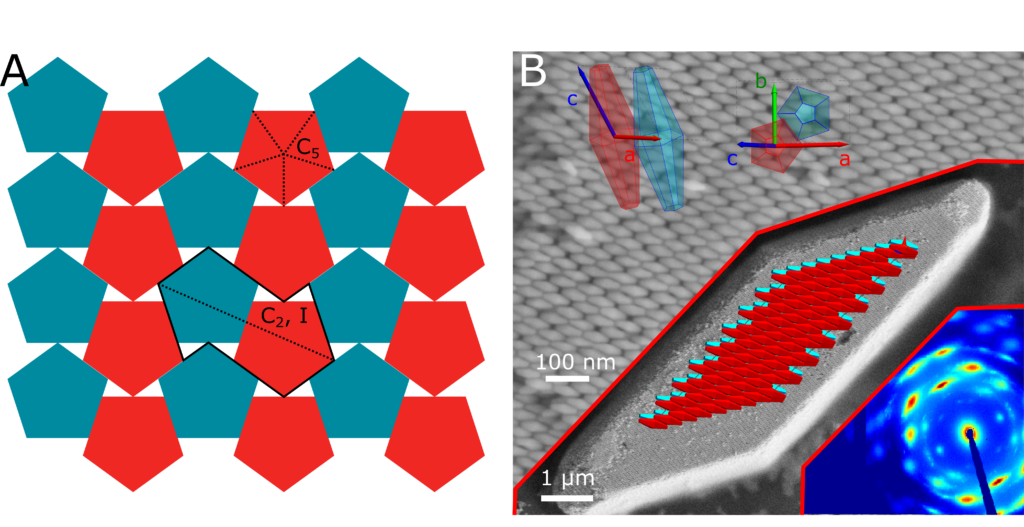Researchers have synthesized crystals of elongated gold bipyramids and have described their optimal packing in three-dimensional assemblies. This result, at the crossroads of chemistry and geometry, offers prospects for the synthesis of nanomaterials with novel symmetries.
The optimal packing of identical objects is a geometric problem that has fascinated scientists since antiquity. The seminal work of Johannes Kepler (1571-1630) described the arrangement of objects with fivefold symmetry, of which regular pentagons attracted a particular attention. Indeed, they cannot tile a plane, except by combining with other shapes. Today, these geometry issues can be studied in nanomaterial science by synthesizing nanoparticles with great control over their shape. Among the most promising morphologies, gold bipyramids with a fivefold symmetry are highly studied objects whose tips allow to strongly modulate their optical response.
Thanks to a careful control of their geometry (elongated nanoparticles with pointed tips and pentagonal base), researchers have been able to crystallize these nanoparticles and describe their organization in in three-dimensional assemblies. A collaboration involving researchers from Laboratoire de Physique des Solides, Institut Charles Sadron, SOLEIL synchrotron (SWING beamline) and CIC nanoGUNE (Spain), demonstrated that these objects form a triclinic lattice, the lowest possible symmetry for a crystal. They also demonstrated that the signal of molecules obtained by Raman spectroscopy is increased in the vicinity of these assemblies, with an intensity depending on the exposed facet of the crystal. This work has been published in Advanced Materials.
The loss of symmetry can be understood through an analogy with the optimal stacking of regular pentagons in the plane (Figure A): the individual objects have a rotational symmetry of order 5, but they associate in pairs, which creates an inversion center I. In doing so, they reduce their rotational symmetry to order 2. In the experimentally obtained crystals, the bipyramids of pentagonal cross-section associate in a quite similar way, with two particles per unit cell (blue and red in Figure B), generalizing the packing of regular pentagons to three dimensions. The assembly was “dissected” by an ion beam to image each slice and reconstruct the three-dimensional structure. By combining this information with X-ray scattering, the lattice symmetry was identified as triclinic. Moreover, numerical simulations reproduce the symmetry and density of the assembly and confirm that it is indeed the most compact solution possible. Thus, nanochemistry meets geometry by going back and forth between synthesis, characterization and modeling. It sheds light on a difficult problem about the optimum stacking of polyhedra and leads to the obtention of nano-materials with original symmetry. The observed modulation of the Raman signal also offers the possibility of an application for the detection of molecules at low concentration.

Figure. A) Optimal packing of regular pentagons in the plane. B) Assembly of pentagonal bipyramids viewed at different scale and in reciprocal space.
Reference
Double-lattice packing of pentagonal gold bipyramids in supercrystals with triclinic symmetry
J. Lyu, W. Chaabani, E. Modin, A. Chuvilin, T. Bizien, F. Smallenburg, M. Impéror-Clerc, D. Constantin, C. Hamon
Advanced Materials, 2022, 2200883
doi: 10.1002/adma.202200883
HAL Id: hal-03648507, version 1
Scientific news from CNRS Institute of Physics
Contacts
Frank Smallenburg
Marianne Impéror-Clerc
Cyrille Hamon
